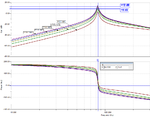Englewood
Full Member level 3
I have 3 outputs of a Wien Bridge Oscillator.
I need to compare the performance of each graph, each graph has been modified by a component.
1st graph with a 21k res
2nd with a 22k res
3rd with 2 diodes added.
I can see that when I have changed the resistor that the time base of the oscillator has decreased and the oscillation occurs earlier.
Adding two diodes to the circuit seem to clip the voltage to 6v



I need to compare the performance of each graph, each graph has been modified by a component.
1st graph with a 21k res
2nd with a 22k res
3rd with 2 diodes added.
I can see that when I have changed the resistor that the time base of the oscillator has decreased and the oscillation occurs earlier.
Adding two diodes to the circuit seem to clip the voltage to 6v



